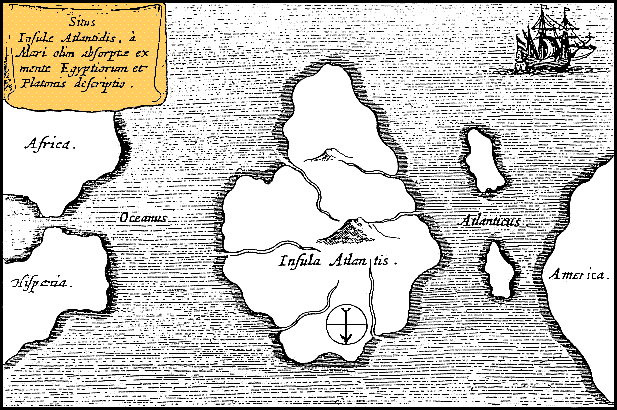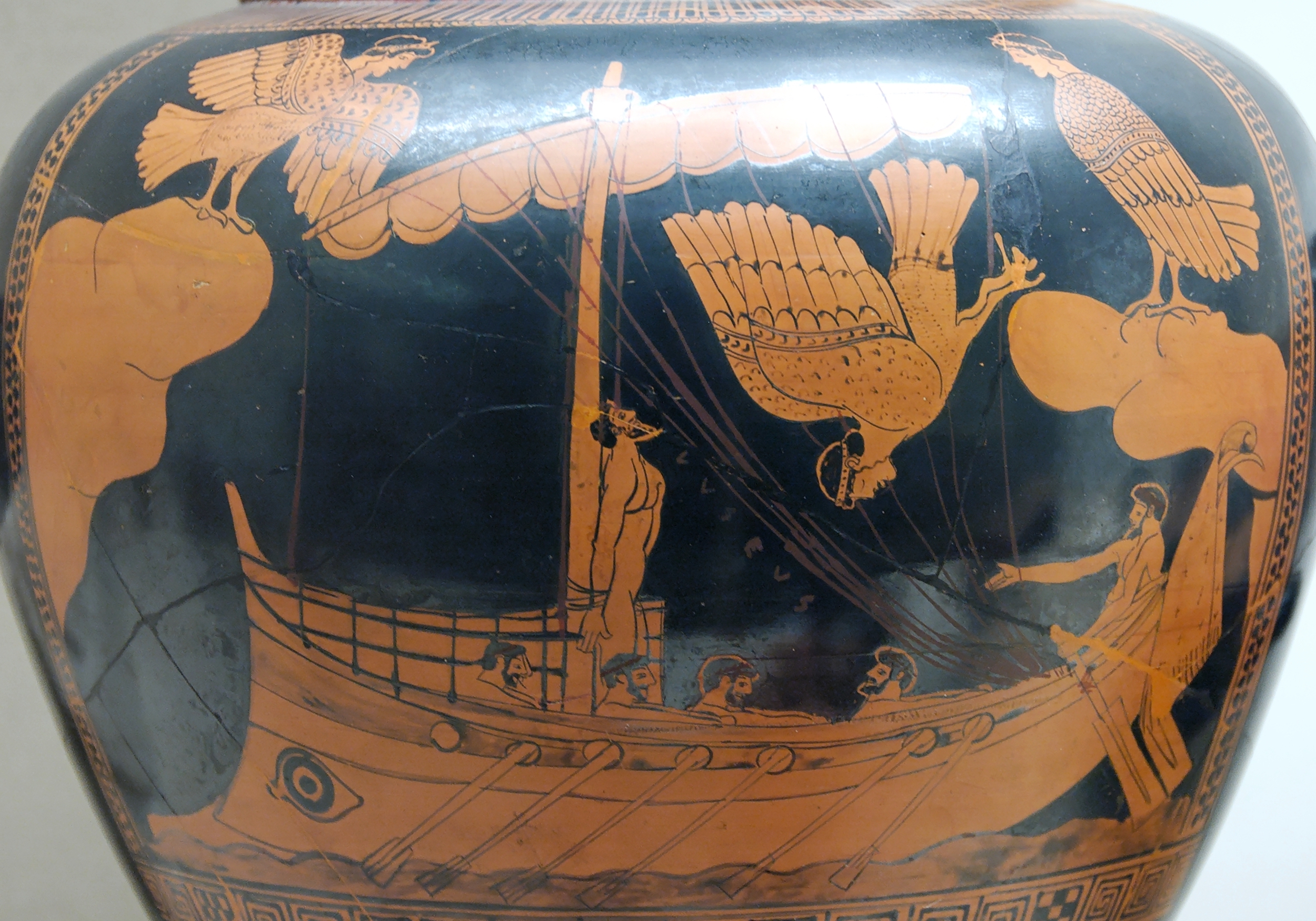July 2013
NascoBLOG 3

Athanasius Kircher's Map of Atlantis (c.1669). Note that north is at bottom.
Hello again. Welcome to NascoBLOG3
How did you get on with the NascoBLOG2 question? I would like very much to hear the route you chose and what you looked for in the way of evidence of Phoenician activity. Don't forget, Google Earth is a wonderful tool and can make you feel you are actually on expedition. Maybe, you too, will make some new and exciting discoveries. If you wish I will publish them for you on NascoBLOG.
(Please don't forget - all pictures downloaded via G.E. must have a full Attribution in place)
In NascoBLOG2 we touched upon a theme which appears to link Greek Mythology with the discoveries described in "Portraits of the Gods" - either the book or the brief resume' on my Book's Promo video.
Historical background
First and foremost let me give you a little historical background. Phoenicia was a commercially orientated Empire of Sea Peoples who had created new markets world-wide for their goods and raw materials like gold, silver and iron ore, but especially tin which was used in the manufacture of bronze artifacts.
It is recorded historically that the Phoenicians feverishly guarded commercial knowledge from competitors, like the Greeks, and later the Romans after they had conquered the Greek's major trading port of Carthage on the Mediterranean coast.
However, this begs the question; if that's the case, how does one account for finding sculptures (intaglios) of a multi-cultural society memorialised in perfect condition and harmony right across the Phoenician 'New World Kingdom' of Peru, South America, as described in "Portraits of the Gods"?
Please bear in mind that once a transliteration of the many legends and inscriptions becomes available the whole scenario could change overnight.
The Phoenicians in South America
The main occupation and activity period of the Phoenicians and their compatriots in South America seems to have taken place peacefully in the 800 years between 1200 B.C. and a little after 400 B.C; these dates coincide extremely well with Greek mythology, e.g. Plato 1200 B.C. and Homer 400 B.C. running parallel with the chronology of the Phoenicians 'New World Kingdom', as tabled in "Portraits of the Gods".
The theories in NascoBLOG2 (Mattievitch/Mertz/Pellech) hypothesised that the 'myths' related by Homer suggest Odyssey's voyage was a carefully disguised visit to the Andean region of Peru wherein lay the true 'Kingdom of the Dead' and the approach route, the "Great Highway", was Homer's 'Highway of the Dead'.
It is clear from the statements made by Plato and Homer that they were referring to something other than a 'small' island in the middle of an Ocean. They were adamant that the 'Island' was larger than Libya and Africa put together. They were, of course, referring to a 'Continental' Island - fitting exactly the description of South America.
Add to this the discoveries described in "Portraits of the Gods" - a 'New World Kingdom' crammed full of long dead ancestors and a statue lined "Great Highway" leading from the South Coast of Peru up into the high Altiplano, and there we have it, the perfect location for Homer's 'Kingdom of the Dead' and his 'Highway of the Dead'... on a 'Continental' Island called 'Atlantis'.
In NascoBLOG4 we will discuss the historical background to 'Atlantis 'and why I believe my research programme, quite unwittingly, uncovered one of the World's last great mysteries.
So, my question for NascoBLOG4: Based upon the discoveries described in "Portraits of the Gods" and the mythological tales by Plato and Homer, Do you believe the Phoenicians 'New World Kingdom' could be the long lost island of 'Atlantis'?
To order your copy of "Portraits of the Gods" simply 'Click' the here.
William James Veall
NascoBLOG 2

Artist: Adolf Furtwängler (drawing); Siren Painter (vase)
Odysseus and the Sirens. Detail from an Attic red-figured stamnos, ca. 480-470 BC. From Vulci.
Hello, welcome to NascoBlog2.
As promised in NascoBLOG1, I want to tell you about a truly momentous, historical break-through made after recording photographs transmitted from the Google Earth remote sensing satellite spinning high above the Southern Andes Mountains of Peru.
And, how this unique discovery appears to have resolved one of ancient history's greatest mysteries: Did the Greeks gain a prior knowledge of South America by following in the footsteps of Phoenician Trans-Oceanic Navigators. In other words, is there any grain of truth to the legendary voyage of Odysseus as related in Homer's Odyssey?
By an amazing coincidence I had just hit the button to launch my new Photo-Book "Portraits of the Gods" (incorporating the Lost Lands of the Canaanites… in Peru) on to iTunes, I came across a News Report (GREEK REPORTER USA: Stella Tsoltakidou. June 2, 2013) about a fascinating book published a couple of years ago by Dr Enrico Mattievich, (Denver CO. 2010)
Although I am pretty sceptical about many seemingly 'fringe' publications there was sufficient substance in Dr Mattievich's hypothesis that attracted my curiosity and appeared to make a link with my own research. Further, the Work was supported by (the Late) writer and archaeologist, Henrietta Mertz and by Dr Christine Pellech both specialists in Trans-Oceanic Contacts in the Ancient World.
In spite of the fact that Dr Mattievich's book "Journey to the Mythological Inferno" is based around classical Greco-Roman literature texts - Homers Odyssey and the Cadmus Myth written by Ovid, for example, I am a strong believer that much of ancient mythology is deliberate protectionist 'dressage' to disguise social -political- economic and religious elements of a particular regime.
Dr Mattievich summed up his thesis by proposing that Odysseus' journey to the Underworld, and here I quote: 'actually took place in South America. The River Acheron was the Amazon, after a long voyage up-stream Odysseus met the Spirits of the Dead at the confluence of the Rio Santiago and the Rio Marañon'.*
*Answer to the NascoBLOG 1 question was, therefore, Latitude 4º 25' 50''S and 77º 38' 31''W Longtitude.
Dr Pellech suggested Odyssey's voyage to the 'Kingdom of the Dead' was really a trip to America! And, Dr Mertz believed the legendary voyage was a trip to North America, but she also suggested that Jason and the Argonauts may have navigated down the Eastern Atlantic Coast of South America, passed by the mouth of the Amazon and Rio de Janerio until reaching the Rio de Plata in Argentina then followed a route many kilometres upstream arriving at the Bolivian Altiplano and Tiahuanaco.
So, having introduced Homer's Odyssey into the equation how does this link -up with my particular 'momentous discovery'? Ideally, of course, you need a copy of "Portraits of the Gods" which you can obtain as an E-Book from iTunes: simply Click on to:
http://www.nascodexpublications.com/Portraits.html
Just watching and listening to the video recording on the iTunes URL above will give you an excellent summary with pictures as to what the book and discovery is all about. "Portraits" is a historical non-fiction, not-for-profit publication. Book sales go to support the next vital stage of our research programme.
NascoBLOG3 is due on-line on the 26th July 2013 and will continue today's theme linking Greek mythology to my particular discovery that the Phoenicians not only made visitations to South America but actually took up residence for nigh on 800 years, thus giving birth to their 'Kingdom of the Dead', or in my case, the much more gentile title, 'The Phoenician's Heaven on Earth'.
NascoBlog2 question: If Henrietta Merzt's hypothesis were true for South America and the Phoenician Navigators did enter the interior via the Rio de la Plata: which route might they have taken to reach Tiahuanaco and what evidence of Phoenician activity would you look for if you were part of an expeditionary force heading upstream?
Speak to you all again on the 26th July.
William James Veall